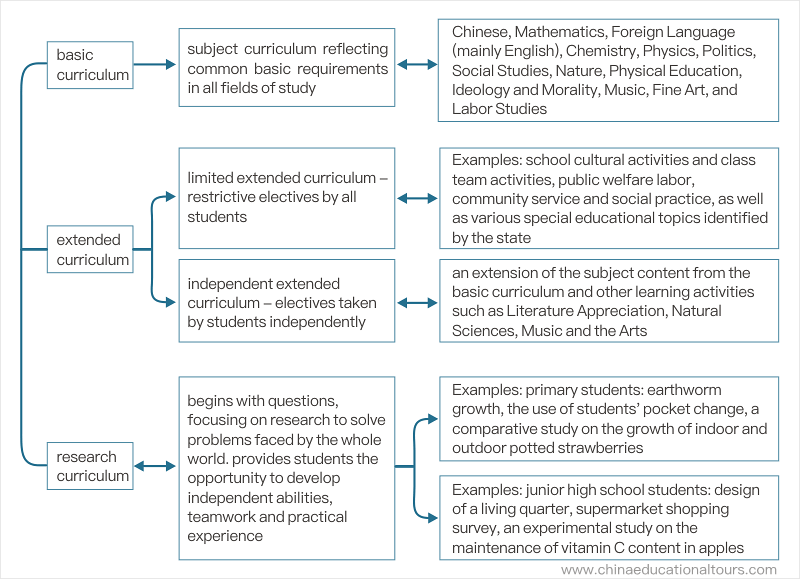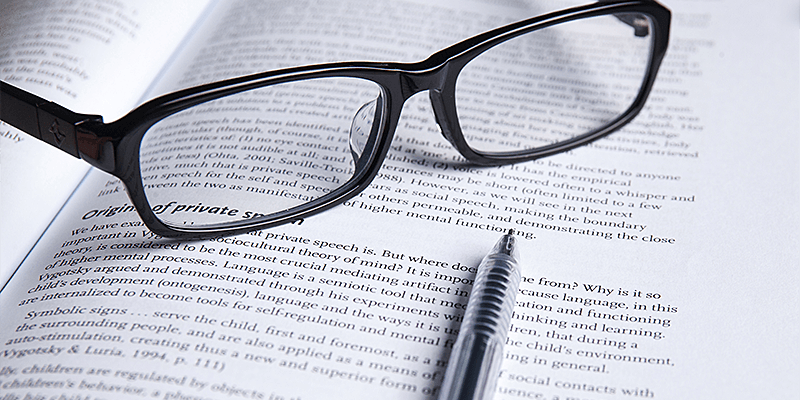The Curricula of Primary and Junior High Schools in China

In 1986, The Compulsory Education Law of the Peoples Republic of China mandated the implementation of its "Nine-year compulsory education" plan, including six years of primary school, and three years of junior high school. There is a set curriculum for each grade to meet the educational and training goals described in the plan. The curricula are guided by two documents: the Teaching Plan and the Teaching Outline, formulated for uniform standards at the top national level, by the Department of Education. The Teaching Plan and Teaching Outline are periodically assessed and updated according to current events, social trends, economic developments and cultural changes.
Different Categories of Primary and Junior High Curricula
At present, the main curricula of primary and junior high schools in China can be divided into the following categories:
1. Basic, extended, and research curricula:
Teaching is designed to impart knowledge, cultivate skills and develop cognitive abilities. To achieve these goals, students need to perceive, understand and consolidate knowledge, put it into practice and then continue to develop their own skills throughout their lives. Thus, under the same system, whether a course is designed to teach facts, develop skills, or perform research defines how it is categorized.

2. Subject content and activities:
Teaching materials vary widely according to both goals and content. Some teaching materials are used for passing on basic knowledge in all fields of study, while others provide hands-on activities and experiential learning. These two curriculum categories complement each other in the comprehensive development of education.

Students absorb traditional cultural knowledge through different subject curricula, such as Reading, Math, Science, Health, and Social Studies as the knowledge base of experience activity curriculum.
Then by participating in the experiential learning activity, students can step out of the classroom and apply knowledge independently in practical activities to develop their enthusiasm, initiative and creativity. For instance, activities can vary from observing the starry sky to practicing a buying and selling. Each is designed to have an accurate understanding of the personal connections among nature and society.
3. Subject and integrated curriculum is tailored to the age and knowledge level of students:
It is understood that it is difficult for students in lower grades to sustain their focus on one activity over extended times. Similarly, subject matter difficulty is tailored to fit the abilities of the student in an age- and ability-appropriate manner.
The primary school curriculum is integrated and more flexible and variable in learning content. This helps maintain students' attention during class time and cultivates their passion of learning. Most of primary schools choose Morality, Arts, Health and Science as integrated curricula. Chinese, Mathematics and English are taught as separate - subjects. As students develop their knowledge bases, entering junior high school, the single-subject curriculum expands to Chinese, Mathematics, Chemistry, Physics, Foreign Language, and Politics.

4. Other categories:
Curricula can be divided into national, local, and school-based oversight at the administrative level. It can be also divided into required content and electives according to the arrangement of teaching plan.
The Curriculum of Primary School
There are six years of compulsory primary school education, divided into two semesters per year for each grade. The exact curriculum in each provincial level varies. Here we show the curricular plan of a primary school in Beijing as an example.
The Curriculum Structure
| 39 weeks per school year | ||
| 35 weeks of classes | 2 weeks of review and examinations | 2 weeks of flexible arrangements (such as hold school traditional activities, cultural festivals, sports meetings, study tours) |
| 5 school days per week | ||
| 6 to 7 classes per day | ||
| 45 minutes per class | ||
| On average, at least 10% of the class hours of each subject should be used for practice activities curriculum. | ||
The Main Courses of the Curriculum in Primary School
Apart from Chinese and Mathematics, which are required in every primary school, the integrated curriculum and integrative practical activities vary from province to province. We can compare the differences between Beijing and Shanghai from the timetables shown below:
Grade One of Beijing Primary School
| Monday | Tuesday | Wednesday | Thursday | Friday | |
| Morning | |||||
| 1 | Mathematics | Chinese | Chinese | Chinese | Mathematics |
| 2 | Fine Arts | Mathematics | Mathematics | Physical Education | Chinese |
| 3 | Chinese | Physical Education | Chinese | English | Music |
| 4 | Aerobics | Chinese | Physical Education | Chinese | Physical Education |
| Afternoon | |||||
| 5 | Fine Arts | Traditional Culture | English | Mathematical Thinking | Integrated Practice |
| 6 | Class Meeting | Morality and Life | Music | Morality and Life | Integrated Practice |
Grade One of Shanghai Primary School
| Monday | Tuesday | Wednesday | Thursday | Friday | |
| Morning | |||||
| 1 | Class Meeting | English | Physical Education | Chinese | Music and Games |
| 2 | Chinese | Nature | English | Chinese | Mathematics |
| 3 | Chinese | Mathematics | Mathematics Activity | English | Chinese |
| 4 | Fine Arts | Chinese | Chinese | Morality and Social | Physical Exercise |
| Afternoon | |||||
| 5 | Mathematics | Chinese | Fine Arts | PE and Games | Chinese |
| 6 | Physical Education | Physical Education | Music and Games | Nature | Morality and Social |
The Curriculum of Junior High School
Three years of junior high school education is a part of the Nine-years Compulsory Education policy, and follows primary school. Each school year has two semesters as well. In this stage, the curriculum combines the subject-specific and the integrated topics. The development of integrative curriculum is advocated, and efforts to create conditions to open elective curriculum are encouraged.

The Curriculum Structure
Junior high school shares almost the same curriculum structure with primary school. The differences are as following.
1. In the second semester of Grade 9, the last 2 weeks of class time are used for review and examinations.
2. There are 7 more classes per week than primary schools.
The Main Courses of the Curriculum in Junior High School
The courses of junior high school are mainly Ideology and Morality, Chinese, Mathematics, Foreign Language, Science (or Physics, Chemistry, Biology), History and Society (or History, Geography), Sports and Health, Art (or Music, Fine Arts) and integrative practical activities. Students need to pass the examination of these subjects for graduation: Chinese, Mathematics, Chemistry, Physics, Foreign Language, and Politics. Let's see an example of a junior high school's class schedule:
| Monday | Tuesday | Wednesday | Thursday | Friday | |
| Morning | |||||
| 1 | Biology | History | Biology | English | Chinese |
| 2 | Mathematics | Chinese | Mathematics | Chinese | Chinese |
| 3 | Chinese | English | Politics | Mathematics | English |
| 4 | Physical Education | Mathematics | English | History | Fine Arts |
| Afternoon | |||||
| 5 | Politics | Geography | Mathematics | Know about Europe and America | Local Course |
| 6 | Comprehensive Practice | Information Technology | Physical Education | Biology | Geography |
| 7 | Safety Education | Comprehensive Practice | Comprehensive Practice | Music | Physical Education |
The Improvements of Curriculum Setting
With more than 40 years of curriculum reform in China, we strive for continued improvement. We recognize that we have been paying too much attention to rote learning and grades, neglecting the cultivation of creativity in the process of students' development. The cultivation of the individual and their ability to adapt to society are as important as the study of cultural knowledge. Education experts suggest reforms to the single curriculum model and developments toward diversification. Cultivating students' innovative spirit and practical abilities can now be considered as the central focus of reforming traditional teaching methods.

 China School System
China School System  Primary School
Primary School  Extracurricular Activities
Extracurricular Activities  High School
High School